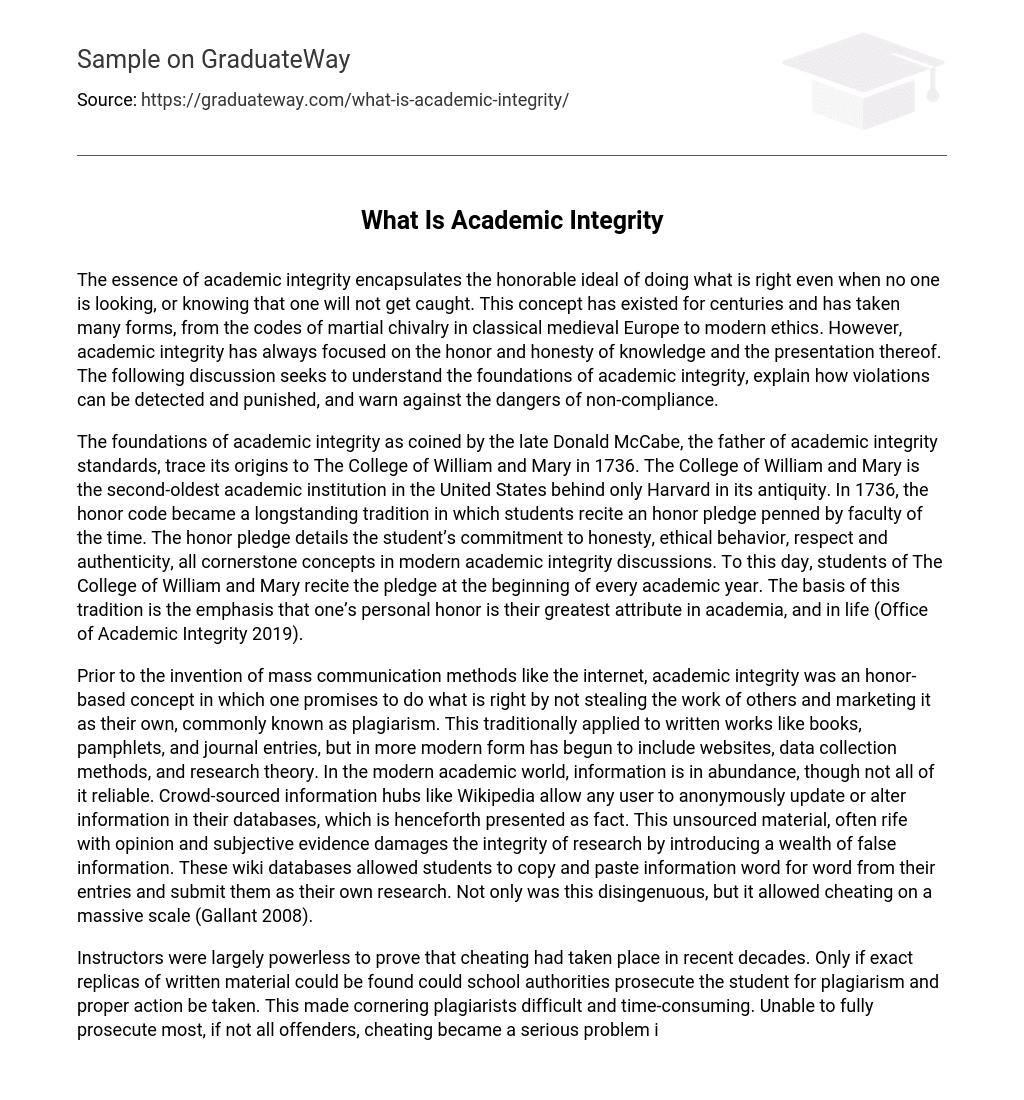The essence of academic integrity encapsulates the honorable ideal of doing what is right even when no one is looking, or knowing that one will not get caught. This concept has existed for centuries and has taken many forms, from the codes of martial chivalry in classical medieval Europe to modern ethics. However, academic integrity has always focused on the honor and honesty of knowledge and the presentation thereof. The following discussion seeks to understand the foundations of academic integrity, explain how violations can be detected and punished, and warn against the dangers of non-compliance.
The foundations of academic integrity as coined by the late Donald McCabe, the father of academic integrity standards, trace its origins to The College of William and Mary in 1736. The College of William and Mary is the second-oldest academic institution in the United States behind only Harvard in its antiquity. In 1736, the honor code became a longstanding tradition in which students recite an honor pledge penned by faculty of the time. The honor pledge details the student’s commitment to honesty, ethical behavior, respect and authenticity, all cornerstone concepts in modern academic integrity discussions. To this day, students of The College of William and Mary recite the pledge at the beginning of every academic year. The basis of this tradition is the emphasis that one’s personal honor is their greatest attribute in academia, and in life (Office of Academic Integrity 2019).
Prior to the invention of mass communication methods like the internet, academic integrity was an honor-based concept in which one promises to do what is right by not stealing the work of others and marketing it as their own, commonly known as plagiarism. This traditionally applied to written works like books, pamphlets, and journal entries, but in more modern form has begun to include websites, data collection methods, and research theory. In the modern academic world, information is in abundance, though not all of it reliable. Crowd-sourced information hubs like Wikipedia allow any user to anonymously update or alter information in their databases, which is henceforth presented as fact. This unsourced material, often rife with opinion and subjective evidence damages the integrity of research by introducing a wealth of false information. These wiki databases allowed students to copy and paste information word for word from their entries and submit them as their own research. Not only was this disingenuous, but it allowed cheating on a massive scale (Gallant 2008).
Instructors were largely powerless to prove that cheating had taken place in recent decades. Only if exact replicas of written material could be found could school authorities prosecute the student for plagiarism and proper action be taken. This made cornering plagiarists difficult and time-consuming. Unable to fully prosecute most, if not all offenders, cheating became a serious problem in academia as the flow of information became less inhibited towards the latter half of the 1990s moving towards the early 2000s. Thankfully, innovation came at the hands of the late Donald McCabe, chief architect and program designer behind the Academic Integrity Seminar, or AIS. AIS is an online and interpersonal system integrated into university standards designed to stop cheating at the source. Beginning with conferences and in-person seminars with officials of a university, certified AIS instructors teach modern educators how to detect violations of academic integrity and properly discipline the offenders. Components of this system include educational seminars, software tutorials, and ethical standards discussions (Anderson 2012).
With the mass-influx of technology in modern academia, software approaches began to blossom under McCabe’s guidance and design. Platforms like TurnItIn and iThenticate became commonplace in university and technical institution alike and utilised a variety of complex algorithms to compare student-submitted work with existing research and published material. If similarities were found between a student submission and a pre-existing publication, a level of severity was assigned based on how close the submission was to its source material. Many universities implemented a safety net protocol in which any similarities beneath twenty percent or so were dismissed as common information duplicates such as scientific abbreviations or common phrases owned by no particular group or individual. The general deterrent of having to submit any work through such software has greatly diminished plagiarism in academia in the last decade (Office of Academic Integrity 2019).
Academic integrity is the basis of trust between all humans in the ever-changing exchange of ideas and information. Though we as a society would like to believe that we are socially evolved enough to be trusted to do our own work and submit our own ideas without taking credit from others, plagiarism remains a constant problem in academia today. The presence of cheating limits the spread of helpful information because it does not facilitate the growth and development of new ideas. Instead, in an academic setting where academic integrity is ignored and plagiarism is allowed to run rampant, the same material is circulated under new names and course identifiers and never has to evolve. Stagnation is the enemy of academics. Without the ability to change, adapt and grow, information becomes outdated, invalid, and useless. It is essential that academic integrity standards be placed at the forefront of all educational institutions and maintained through strict enforcement.
Works Cited
- Office of Academic Integrity. “Integrity Seminars – A Student Development Resource.” Integrity
- Seminars – A Student Development Resource, 4 Dec. 2019, https://integrityseminar.org/.
- Anderson, Nick. ‘Honour and testing at a Virginia university’. The Washington Post. December14, 2012.
- Gallant, Tricia. Twenty-First Century Forces Shaping Academic Integrity. 2008.





